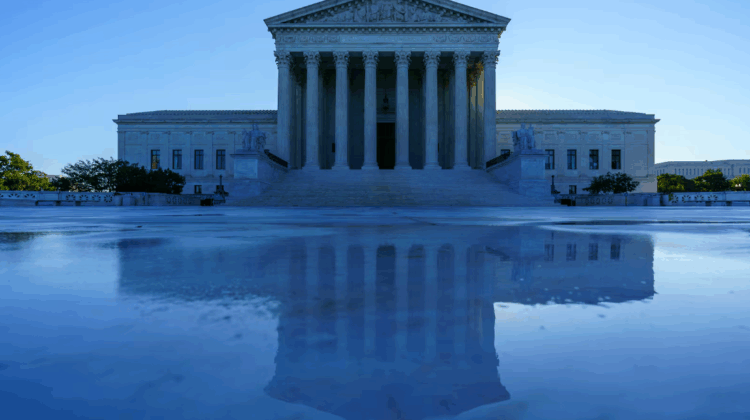SCOTUS Curbs Abuse of Power by Activist District Court Judges
Nationwide universal injunctions can no longer undermine Trump’s mandate.

|
Getting your Trinity Audio player ready...
|
[Want even more content from FPM? Sign up for FPM+ to unlock exclusive series, virtual town-halls with our authors, and more—now for just $3.99/month. Click here to sign up.]
On June 27th, the Supreme Court struck a significant blow against the tyranny of progressive federal district court judges who have used nationwide universal injunctions to tread on the authority of the Executive Branch. Multiple activist district court judges in mostly liberal jurisdictions have taken it upon themselves to bar the government from implementing President Trump’s executive orders anywhere in the nation. These judges have not limited the relief they granted only to the persons or entities who were parties to the original lawsuit. The universal injunctions were designed to provide relief to nonparties as well.
As a result, President Trump’s executive orders have been blocked nationwide on policy matters ranging from downsizing the Executive Branch and cutting federal spending to deportation and barring transgender males from competing in female sports.
Writing the opinion for a 6-3 majority, Justice Amy Coney Barrett explained that such nationwide universal injunctions issued by individual district court judges “likely exceed the equitable authority that Congress has granted to federal courts.” The Court ruled that “The Government’s applications to partially stay the preliminary injunctions are granted, but only to the extent that the injunctions are broader than necessary to provide complete relief to each plaintiff with standing to sue.”
The underlying dispute that prompted this case involved the extent to which President Trump’s executive order prohibiting birthright citizenship for illegal immigrants’ babies born on U.S. soil violates the Constitution’s 14th Amendment. However, The Supreme Court did not reach a decision on the merits of this constitutional issue, which remains to be resolved at another time. The majority in this case focused on the threshold issue of whether individual district court judges have the extraordinarily broad authority to grant plaintiffs’ requests for unrestricted nationwide universal injunctions against implementation and enforcement of executive orders. Justice Barrett’s majority opinion concluded that these judges do not have the authority to grant “such a sweeping remedy.”
Justice Barrett surveyed the limited historical use and scope of a federal court’s authority to issue equitable orders. “The universal injunction was conspicuously nonexistent for most of our Nation’s history,” she wrote. “Because the universal injunction lacks a historical pedigree, it falls outside the bounds of a federal court’s equitable authority under the Judiciary Act.”
Justice Barrett relied on more than historical precedent alone to reach her conclusion that district courts that issue nationwide universal injunctions as a matter of course exceed their judicial authority. The judiciary under Article III of the Constitution has assigned functions, as do the co-equal Legislative and Executive Branches of the federal government. The courts oversee both Congress and the Executive Branch in the context of specific “cases and controversies” that are brought to them by specific parties allegedly injured by specific actions of either of those two branches. It is Congress’s job, not a federal court’s job, to exercise general oversight of the Executive Branch.
“When a court concludes that the Executive Branch has acted unlawfully,” Justice Barrett wrote, “the answer is not for the court to exceed its power, too.”
The three liberal justices – Elena Kagan, Sonia Sotomayor, and Ketanji Brown Jackson – dissented. Justices Sotomayor and Jackson wrote individual dissenting opinions.
“The rule of law is not a given in this nation, nor any other,” Justice Sotomayor wrote. “It is a precept of our democracy that will endure only if those brave enough in every branch fight for its survival. Today, the court abdicates its vital role in that effort.”
To the contrary, the Supreme Court majority adhered to the core constitutional precept of the separation of powers, which applies equally to each branch of government of America’s constitutional republic. Each co-equal branch must not abuse the authority granted to it by the Constitution to interfere with the constitutional authority of each of the other two branches.
The Supreme Court has the duty not only to restrain abuses of power by the Legislative and Executive Branches, but also to restrain abuses of power within the Judicial Branch itself. Only the Supreme Court is explicitly mentioned in the Constitution and has nationwide judicial authority. Lower federal courts are created by Congress and must operate within both the boundaries set by the Constitution and the statutory authority granted by Congress. A federal district court judge – one of hundreds across the country – is not a mini-president with general authority to override, on a nationwide basis, the duly elected president’s policy decisions.
Justice Jackson made no pretense of articulating a reasoned argument rooted in history, legal precedent, or logic in her dissenting opinion. She started out by asserting that “The Court’s decision to permit the Executive to violate the Constitution with respect to anyone who has not yet sued is an existential threat to the rule of law.” That is not what the majority decision did at all. Justice Barrett’s majority opinion made it crystal clear that the Court was not deciding the underlying constitutional issues in the case regarding birthright citizenship at this point. But the opinion did insist that there is a right way and a wrong way for federal courts to proceed with rendering their judgments on the scope of relief they grant to nonparties to avoid stepping over the boundaries of their own authority.
Justice Jackson concluded her dissenting opinion declaring that “I lament that the majority is so caught up in minutiae of the Government’s self-serving, finger-pointing arguments that it misses the plot.” It is Justice Jackson who is missing the real plot. Disaffected leftwing progressives have plotted to forum shop for friendly unelected rogue judges willing to abuse their judicial power by blocking across the nation the policy decisions of the duly elected president of the United States.
Displaying a shocking abdication of her responsibility as a Supreme Court justice, Justice Jackson downplayed the significance of inquiring into the sources that explain the reasons for limitations on judicial authority as a “a mind-numbingly technical query.”
In a strongly worded rebuke to Justice Jackson’s contention in her dissenting opinion that a single district court’s declaration of what the law is regarding an executive action should be binding universally, Justice Barrett wrote: “JUSTICE JACKSON decries an imperial Executive while embracing an imperial Judiciary. No one disputes that the Executive has a duty to follow the law. But the Judiciary does not have unbridled authority to enforce this obligation—in fact, sometimes the law prohibits the Judiciary from doing so.”
Justice Barrett advised Justice Jackson “to heed her own admonition: ‘[E]veryone, from the President on down, is bound by law.’” To emphasize the point, Justice Barrett added, “That goes for judges too.”
The class action route is still available to seek broad judicial relief in certain cases, which some plaintiffs are already pursuing in response to losing the shortcut of obtaining nationwide universal injunctions from friendly district court judges. Class actions allow one or more members of a class to sue or be sued as representative parties on behalf of all similarly situated nonparties who are deemed members of that class. But litigants cannot just snap their fingers and be automatically designated as representatives of a class of nonparties for the purpose of obtaining relief in the federal courts for all nonparties included in a supposed class. They must satisfy certain procedural safeguards built into Federal Rule of Civil Procedure 23 (Class Actions) for their case to be certified as a class action.
Not to get too much into the weeds, but to satisfy the requirements for class action certification under Rule 23 the class must be “so numerous that joinder of all members is impracticable.” There must be “questions of law or fact common to the class.” Moreover, it is required that “the claims or defenses of the representative parties are typical of the claims or defenses of the class,” and that “the representative parties will fairly and adequately protect the interests of the class.” Rule 23 also requires a finding by the court that “the questions of law or fact common to class members predominate over any questions affecting only individual members, and that a class action is superior to other available methods for fairly and efficiently adjudicating the controversy.”
Courts considering class action certification must first go through a rigorous analysis to establish the eligibility of the party or parties claiming to represent a class and to define the proper scope of that class.
As Justice Barrett noted, “None of these requirements is a prerequisite for a universal injunction,” which is merely “a shortcut to relief that benefits parties and nonparties alike” while circumventing “Rule 23’s procedural protections.”
The Supreme Court’s landmark decision upholds the rule of law by redressing the abuse of power by activist rogue district court judges. President Trump will thereby be able to fulfill the mandate that the American people have given him without interference by “an imperial Judiciary.”

